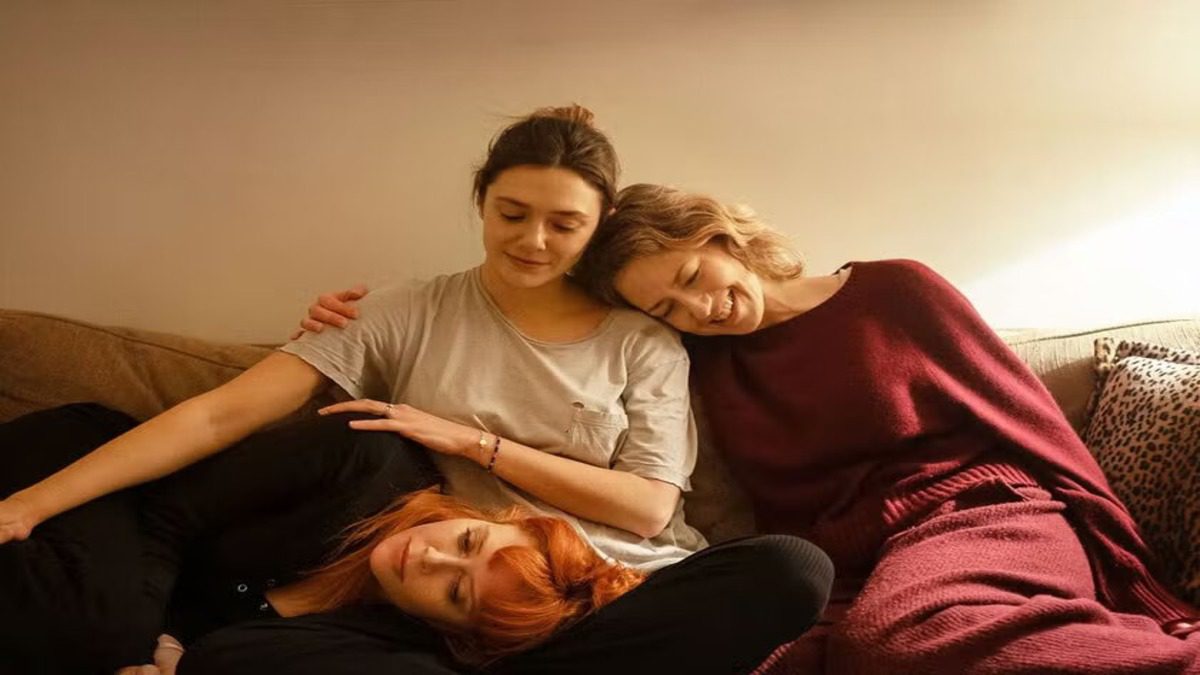Carrie Coon, Elizabeth Olsen and Natasha Lyonne in “His Three Daughters,” directed by Azazel Jacobs.Credit…Netflix
Netflix’s Transcendent New Movie Stuns Viewers with a Modern Take on King Lear
On September 20, 2024, Netflix released His Three Daughters, a film directed by Azazel Jacobs that has quickly captivated audiences with its raw portrayal of family dynamics. The movie has been praised for its intimate setting and complex relationships, drawing comparisons to Shakespeare’s King Lear but with a modern twist. The story revolves around three daughters, Katie (Carrie Coon), Rachel (Natasha Lyonne), and Christina (Elizabeth Olsen), who come together to care for their dying father, Vincent (Jay O. Sanders). As they struggle with old wounds and simmering tensions, the film delves deep into the emotional landscapes of these sisters.
Though Vincent is far from the grand figure of King Lear, his presence looms large over the movie. He’s a retired mid-level government worker, living out his final days in a modest Manhattan apartment. As the sisters gather to say their goodbyes, the apartment becomes a symbolic kingdom, a place where childhood memories and unresolved conflicts come crashing together.
The movie is almost entirely set within the confines of Vincent’s apartment, which heightens the tension among the sisters. Their interactions reveal the strained relationships they’ve had with each other and their father. Katie, the eldest, lives in Brooklyn and has a distant relationship with the family. Christina, the youngest, has built a life far away, while Rachel, the middle sister and stepsibling, has lived with their father and been his primary caregiver. Their proximity and the weight of their past relationships create an explosive dynamic as they navigate Vincent’s final days.
The film opens with Vincent in the late stages of cancer. He is mostly unconscious, and two hospice workers rotate shifts to provide care, leaving the sisters with the uncomfortable task of facing each other and their unresolved issues. These interactions form the heart of His Three Daughters, as the sisters attempt to reconcile their different life choices and the childhood roles they continue to play in each other’s lives.
Katie is portrayed as the high-strung and bossy older sister, a woman overwhelmed by her professional and personal responsibilities. Christina, on the other hand, is portrayed as the calm, zen-like middle child who lives a hippie lifestyle. Rachel, who is both the caregiver and the family’s black sheep, lives in the apartment with her father. She has no steady job and spends much of her time gambling and smoking weed, activities that her sisters criticize her for.
The tension between Katie and Rachel is palpable from the start, with frequent arguments and power struggles. Katie’s controlling nature clashes with Rachel’s laid-back attitude, while Christina is stuck in the middle, trying to keep the peace. As the sisters bicker over trivial matters like chores, their deeper conflicts begin to surface. Katie’s resentment over Rachel’s closeness to their father, Rachel’s feeling of being an outsider in her own family, and Christina’s desire to maintain harmony all come to a head in a series of emotional confrontations.
While His Three Daughters may seem like a family drama on the surface, it’s much more than that. The film captures the complexities of sibling relationships and how family ties can be both a source of strength and division. The sisters’ love for their father is evident, but it’s also clear that their relationships with him—and each other—are fraught with tension and unresolved feelings. As the story unfolds, the movie’s central question becomes: how can these women reconcile their differences while caring for the man who raised them?
Azazel Jacobs’ direction is subtle but powerful, allowing the emotional depth of the characters to take center stage. The claustrophobic setting of the apartment adds to the intensity of the story, forcing the characters to confront each other in a space that feels both familiar and suffocating. The cinematography by Sam Levy is also worth noting, as it transforms the apartment into a battleground of emotions, with each room representing a different aspect of the sisters’ shared history.
The performances by Coon, Lyonne, and Olsen are nothing short of brilliant. Each actress brings a unique perspective to her character, making the sisters feel real and relatable. Their chemistry is undeniable, and their interactions—whether filled with love or conflict—are gripping to watch. Jay O. Sanders, though mostly confined to a hospital bed, delivers a touching portrayal of a man at the end of his life, leaving his daughters to grapple with the legacy he leaves behind.
While the movie has moments of humor, it’s primarily a meditation on loss, family, and the passage of time. The sisters may not be battling for a throne, as in King Lear, but their struggles are no less significant. They are fighting for their place in each other’s lives, trying to find meaning in their shared history, and searching for a way to move forward after their father’s inevitable passing.
As the film draws to its conclusion, the sisters are left to face not only the loss of their father but also the realization that their relationships with each other are forever changed. His Three Daughters doesn’t provide easy answers or a neat resolution. Instead, it offers a poignant look at the complexities of family life and the ways in which love and conflict are intertwined.
Audiences have responded strongly to the movie’s emotional depth and the raw performances of its lead actresses. With His Three Daughters, Netflix has delivered a film that resonates on both a personal and universal level, making it a must-watch for anyone who has ever experienced the highs and lows of family life.
#HisThreeDaughters #NetflixMovie #FamilyDrama #SiblingRivalry #MustWatch
